Hybrid Detective Stories
DD0317 Bromeliad Taxonomy for Beginners by Aaron Smythe, March 2015.
My reasons for writing this document was firstly, I love bromeliad species and secondly, I wanted something other than drawings to help differentiate the various parts of the bromeliad as described in situ. I have attributed different botanical terms to photos of the three main components described by botanists. These components are;
1. The "plant itself". Usually the leaves, sheaths and blade are commented on.
2.This next one is the inflorescence (the fertile part of the plant) and contains such features as peduncle of the inflorescence, bracts and rachis.
3.The flower which involves petals, sepals, ovary, pedicel, floral bracts anther, stamen and stigma.
4. The implements that I use
There are also various Latin terms to describe diverse components of those listed above such as colour, shape pattern etc. I will not go into these here but can be researched in the link below-
http://fcbs.org/articles/Glossary/Glossary-plus.pdf#page=1&zoom=auto,0,800
When identifying a bromeliad these terms can be used to rule “in or out” for a species.
1. The “plant itself"
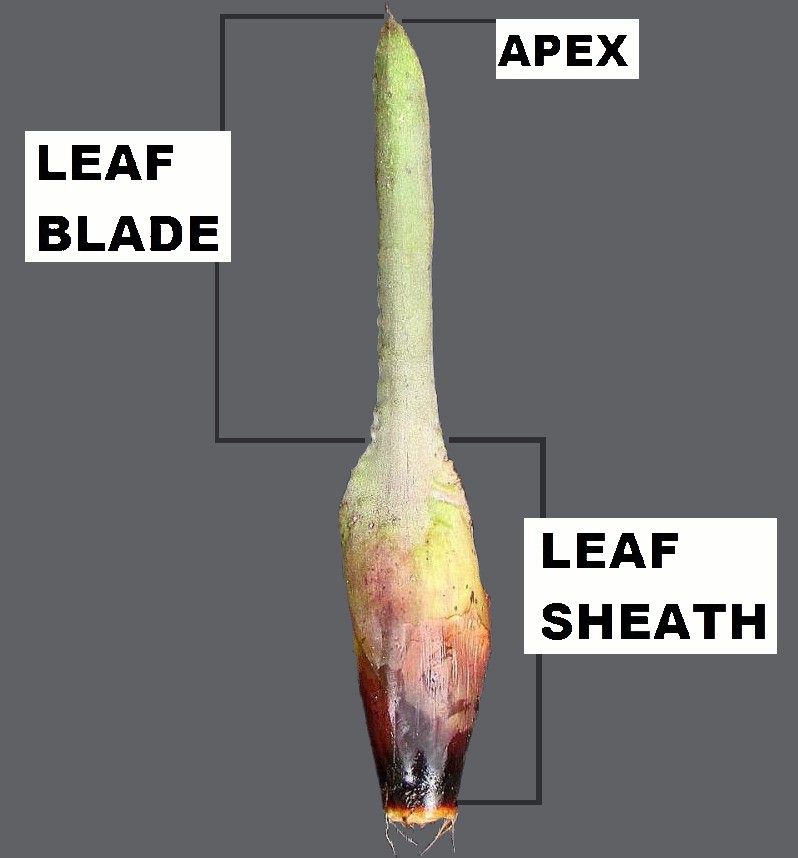 The plant structure of a bromeliad is formed by a rosette of leaves radiating from a crown. The focal parts of the leaf are the leaf sheath, leaf blade, apex and margin. The leaf sheath is the wider bottom part of the leaf that wraps around the base. The leaf blade is the upper part which protrudes from the blade. The apex is the tip or end of the leaf and the margins are the outside of the leaf. A bromeliad plant can be arranged alternately (distichous) as well as rosette (polystichous).
The plant structure of a bromeliad is formed by a rosette of leaves radiating from a crown. The focal parts of the leaf are the leaf sheath, leaf blade, apex and margin. The leaf sheath is the wider bottom part of the leaf that wraps around the base. The leaf blade is the upper part which protrudes from the blade. The apex is the tip or end of the leaf and the margins are the outside of the leaf. A bromeliad plant can be arranged alternately (distichous) as well as rosette (polystichous).
2. The Inflorescence
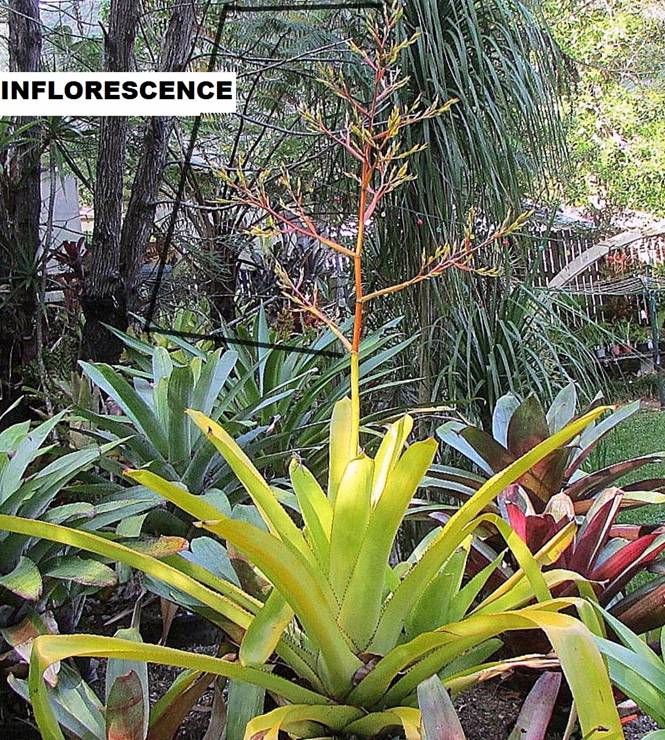 Only the non-ambiguous fertile section of the inflorescence is marked here. The section considered to be the inflorescence for the plant is thought of differently amongst botanists but should mean all parts for displaying flowers including peduncle.
Only the non-ambiguous fertile section of the inflorescence is marked here. The section considered to be the inflorescence for the plant is thought of differently amongst botanists but should mean all parts for displaying flowers including peduncle.
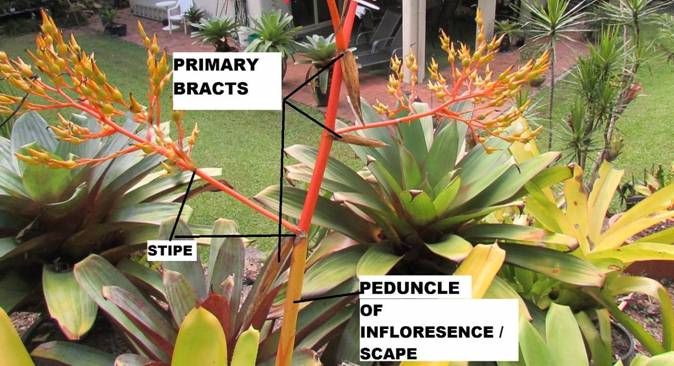 The area holding the inflorescence is the “peduncle of inflorescence” which is the stalk of the inflorescence. The “stipe” is a term used to cover the bottom part of a branch.
The area holding the inflorescence is the “peduncle of inflorescence” which is the stalk of the inflorescence. The “stipe” is a term used to cover the bottom part of a branch.
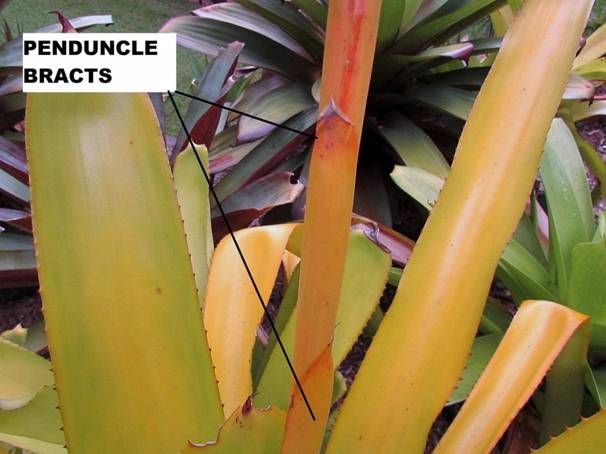 Peduncle bracts are located on the peduncle. Bracts are a modified type of leaf.
Peduncle bracts are located on the peduncle. Bracts are a modified type of leaf.
3. The Flower Itself
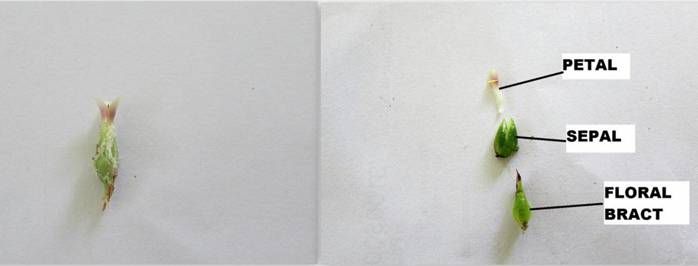 The flowering structure has 3 main external parts which are the petal (leaf like structure), sepal (contains the petals) and floral bract.
The flowering structure has 3 main external parts which are the petal (leaf like structure), sepal (contains the petals) and floral bract.
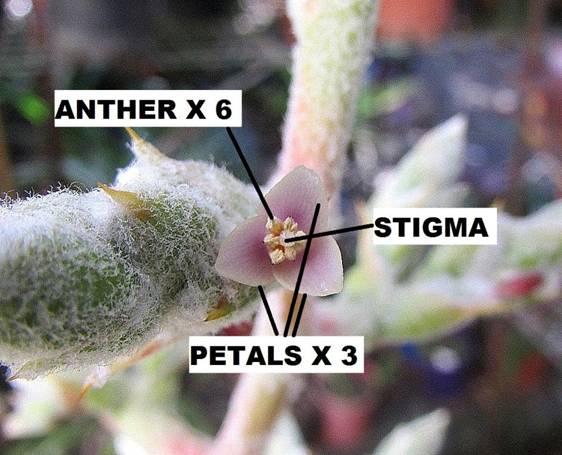 The internal components in this picture are the anther (the pollen bearing part at the top of the stamen and the stigma (the top of the female portion of the flower that receives pollen). There are 6 x anther, 1 x stigma and 3 petals in bromeliads. The stigma is the terminal section of the female organ, which is called a carpel. The anther is the terminal section of the male organ, which is called a stamen.
The internal components in this picture are the anther (the pollen bearing part at the top of the stamen and the stigma (the top of the female portion of the flower that receives pollen). There are 6 x anther, 1 x stigma and 3 petals in bromeliads. The stigma is the terminal section of the female organ, which is called a carpel. The anther is the terminal section of the male organ, which is called a stamen.
4. The Implements that I use.
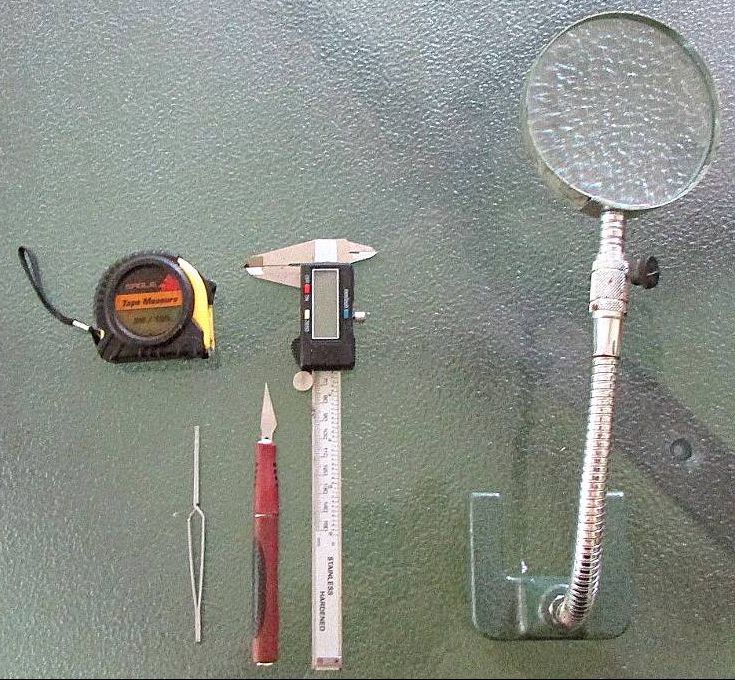 From left - Tape measure for the larger measurements, tweezers, a sharp scalpel type knife, a digital calliper for the smaller measurements and a magnifying glass as I am not as young as I used to be.
From left - Tape measure for the larger measurements, tweezers, a sharp scalpel type knife, a digital calliper for the smaller measurements and a magnifying glass as I am not as young as I used to be.
I have been told by those who have been doing this sort of thing for a long time that I am very brave as taxonomy will drive me insane and that all taxonomists argue! I have tried to keep this simple for myself and others who are venturing down the road of deciphering species and their descriptions.
All you will need to do now is learn the Latin (link to glossary above) that describes colour, pattern, shape etc and take your measurements.
Have fun and as Lyman Smith said "Botany is an art as well as a science."
Aaron Smythe, Cairns, March 2015
Updated 16/03/17







